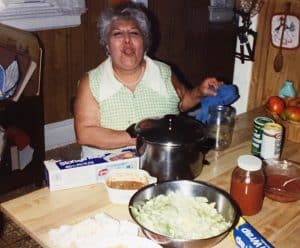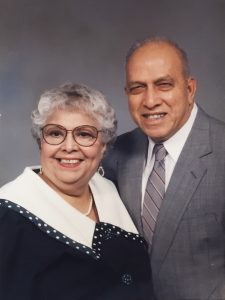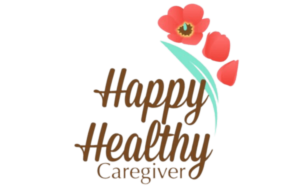a guest post written for Happy Healthy Caregiver by Maria Lindbergh
When discussing her end-of-life wishes, Granny left no room for doubt on her stance, “I never want to live in a nursing home! Put me down if it ever comes to that!”
Granny was crystal clear about her desire to live at home with my grandfather for the remainder of her life. Naturally, my Mom and I were on board with that plan. We wanted to do everything in our power to make that happen, and I personally wanted to give back to the woman who gave me so much love and support throughout my life.
I truly believe that everyone deserves to have the option to live at home no matter the circumstances. But every situation and person is unique, and there’s no one-size-fits-all approach to deciding if you can help your family member live at home. Here’s how we decided to support Granny during this transition. Be warned, I’m not trying to oversimplify the process (what process isn’t complicated when it comes to caregiving, right?!), but hopefully, you’ll be able to take away some ideas on how to navigate this with your family and loved ones.
Consider what your family member can do.
First, you need to consider what your family member can do for themselves. In Granny’s situation, we asked questions like:
- What does Granny do at home without any help?
- Can Granny take care of herself while taking a bath and using the toilet?
- Is she doing the cleaning, laundry, and cooking around the house?
- Does she get her own groceries and take herself to the doctor?
- Is she refilling her medicine and taking it as prescribed?
- Are the bills being paid on time?
I was very close to my grandmother and knew her abilities well. Granny took her own showers, used the bathroom, dressed, and groomed with no help whatsoever. She also did light cleaning, like washing dishes and dusting around the house. When she was feeling well and the weather was fair, she would also come with me to the grocery store.
Granny was known as the cook in our family and made excellent Mexican cuisine. Toward the end of her life, she made simple meals on the stovetop or used the microwave while perched on her kitchen stool. For more complicated recipes, she took on the role of “kitchen supervisor” and instructed family members on what to do.
Is there something they need help with?
After examining what your family member can do, now it’s time to look at the things your family member needs assistance with while taking care of themselves, their home, and errands outside the home.
There are two main types of assistance: physical and non-physical. Physical assistance may look like when your family member needs help standing up from a chair. Non-physical assistance may be reminding your family member to brush their teeth or waiting outside the bathroom in case they need something in the shower.
Granny needed physical assistance with a lot of household chores. Deep cleaning and going up and down the steps to do laundry in the basement were becoming treacherous ordeals. Granny could no longer reach to change light bulbs or carry awkward bulky things like the garbage bins. She also found it tricky to keep her balance while walking in the yard, so she needed someone to help water her flower beds. On the self-care front, Granny’s arthritis made it hard to hold the clippers to trim her toenails.
Can you help your family member?
After you identify what your family member can and cannot do, now ask if you can help your family member with the things they need help with?
When it came to Granny, my mother and I were a team. We delegated caregiving duties while working full-time jobs, going to school, and taking care of our own homes. Mom took Granny to the doctor, planned family visits, and scheduled times at the beauty salon for pedicures and haircuts. I helped Granny around the house by carrying things up and down the stairs, managing finances, refilling and organizing medications, grocery shopping, taking out the trash, and shoveling snow. Sometimes, other family members could pitch in and help Granny out, too.

My grandparents lived on a fixed income, and there wasn’t much leftover money after paying the bills. Despite the lack of funds, we were able to hire a yard service company to take care of the lawn and flower beds. We were also able to connect with a social worker who shared a lot of information about local resources to help my grandparents. The most helpful resource was a stipend granted by the county senior services department that provided in-home care services.
The in-home care services provided a personal care attendant to come twice a week for four hours to do laundry, cleaning, and meal prepping. The in-home care was a tremendous help; it brought some extra balance to the responsibilities in my own life. When I went to visit Granny, I didn’t feel like I had a list of 800 things to complete, which ultimately led to me spending more time with her drinking cappuccino and eating donuts.
Do you want to help your family member?
When it came to Granny, my Mom and I wanted to help her achieve her wish of living in her own home. We educated ourselves on the resources available, we made the time, and we had the drive to make Granny’s wish come true.
While I can only speak for my experience, I know that in reality, not everyone feels the same way about their family or loved ones. You need to remember to BE HONEST with yourself. If you do not have the physical, mental, or emotional capacity to be able to help, that’s okay. There’s nothing wrong with that. Whatever the reason may be, you need to be true to yourself and not commit to a situation where you could later be resentful because of this obligation.
If you find yourself not wanting to take on this role, share your thoughts with your family member and find other options! Social workers can be incredibly helpful in finding options, like senior living facilities or other community services. To find out what’s available in your community, visit the National Association of Area Agencies on Aging.
Maria Lindbergh, MOT, ECHM, OTR/L is an occupational therapist who has helped hundreds of older adults in their living space, nursing homes, and hospitals across the greater Kansas City area. Maria treasures her time as a caregiver for her grandparents before their passing in 2016 and 2019. This experience inspired her to create Stay at Home Solutions, a resource for caregivers to learn the best changes to make at home for their family members to live safely and independently.




